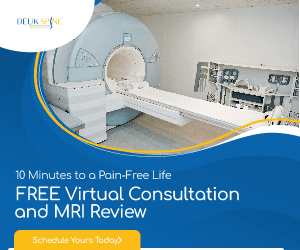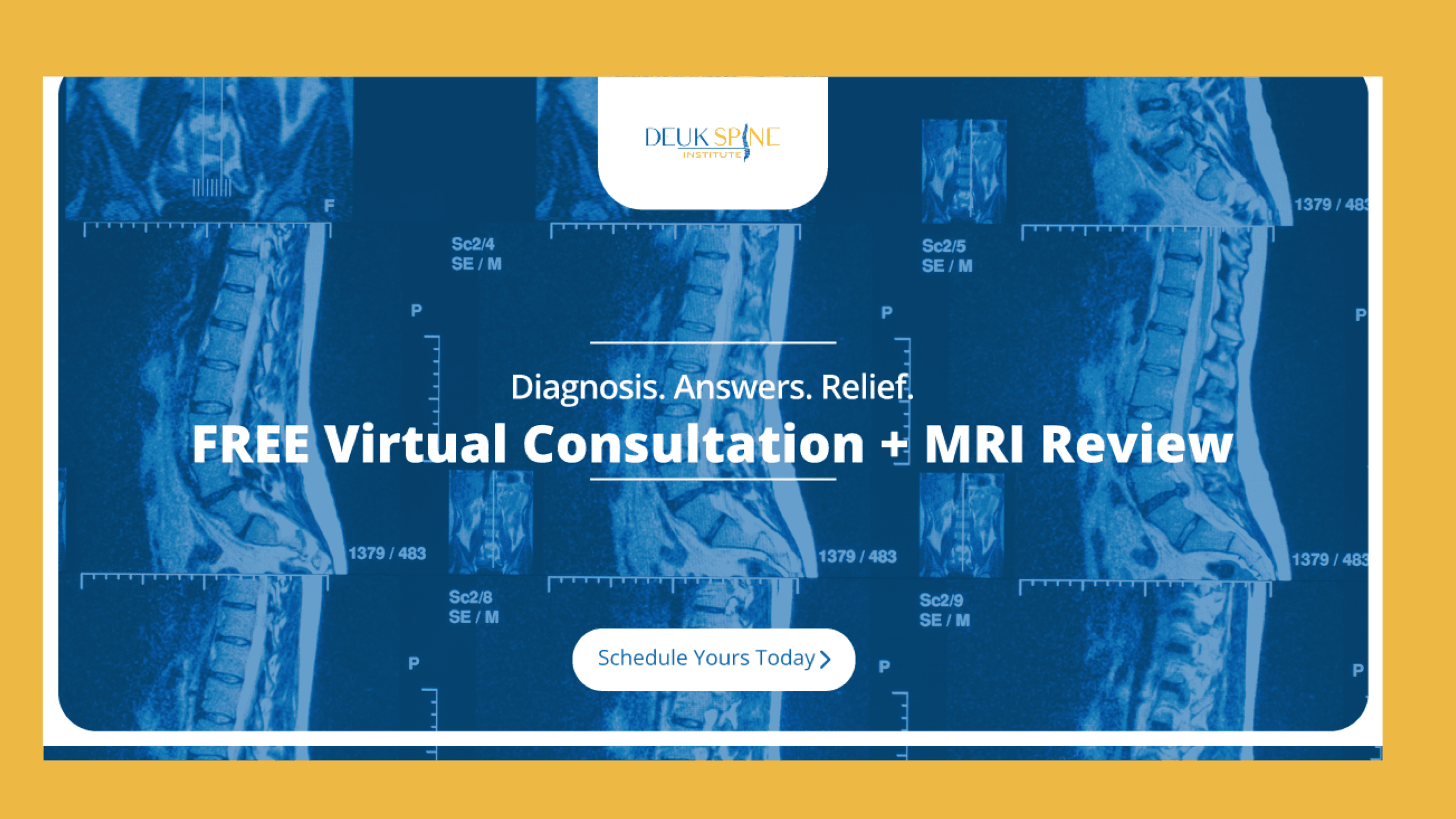
A C6-C7 disc herniation is a common spinal condition that can cause significant pain and loss of function. It occurs at the intervertebral disc located between the sixth and seventh vertebrae in the lower part of the cervical spine (neck).
The C6 and C7 vertebrae are crucial for neck support, making them particularly susceptible to damage.
How Does a Disc Become Herniated?
Discover the mechanics behind cervical disc herniation.
The C6-C7 Anatomy and the C7 Nerve Root
The intervertebral disc itself acts as a soft, shock-absorbing joint, consisting of a tough outer wall, the annulus fibrosus, which contains a gel-like center, the nucleus pulposus.

Image: MRI scan showing C6-C7 disc herniation.
A disc herniation occurs when a tear develops in the annulus fibrosus, allowing the nucleus pulposus to leak out and press on nearby nerves. For a C6-C7 herniation, the compressed structure is typically the C7 nerve root, which controls key functions in the upper body.
Causes of C6-C7 Disc Herniation
While trauma can cause a herniation, the condition most commonly results from a combination of factors:
- Spinal wear and tear (degeneration): As we age, the discs lose elasticity, and the cartilaginous ligaments that hold them together can weaken, making them more prone to tearing.
- Acute trauma or injury: Sudden impacts from accidents, falls, or excessive force (e.g., from heavy lifting or poor posture) can cause the disc to rupture.
C6-C7 Herniated Disc Symptoms
Compression or inflammation of the C7 nerve root leads to a condition called cervical radiculopathy. Symptoms of a C6-C7 herniation often include:
- Radicular pain: A hot, spreading sensation that radiates from the base of the neck, through the shoulder, and down the arm.
- Numbness and tingling: A lack of sensation, often described as a "pins and needles" feeling, in the shoulder, arm, palm, index, and middle fingers.
- Muscle weakness: Difficulty or weakness in moving the elbow, wrist, and fingers, particularly in the triceps muscle.
- Associated discomfort: Neck pain, headaches, chest pains, and in rare cases, uncontrollable sweating.
Symptoms are commonly misdiagnosed; for example, radicular pain and numbness and tingling can be misdiagnosed as fibromyalgia—a condition with no cure. In many cases, seeking a second opinion is crucial.
Suffering From Chronic Pain?
Get answers today, schedule a free consultation and MRI review with Dr. Ara Deukmedjian.
Treatment and Recovery Options
Treatment for C6-C7 disc herniation ranges from conservative management to advanced surgical intervention, depending on the severity of the symptoms.
1. Non-Surgical Treatments
The initial focus is on pain relief, reducing inflammation, and improving mobility:
- Physical therapy: Targeted exercises to strengthen neck muscles, improve posture, and increase flexibility.
- Medications: Nonsteroidal anti-inflammatory drugs (NSAIDs) to manage inflammation and pain. Muscle relaxants or oral steroids may also be prescribed.
- Activity modification: Avoiding heavy lifting, repetitive neck movements, and activities that worsen pain.
- Injections: Interventional pain management techniques, such as epidural steroid injections, to reduce inflammation around the nerve root.
2. Surgical Treatments
When non-surgical options fail to provide lasting relief, surgery may be necessary. Traditional procedures include microdiscectomy and spinal fusion. However, these come with complications and often fail over time.
The most advanced option is Deuk Laser Disc Repair® (DLDR), a minimally invasive endoscopic procedure.
- How DLDR® Works: It requires a very small incision (less than a quarter inch) and uses a gentle process to separate muscles, avoiding cutting bone. This technique allows a surgeon to directly access and repair the painful tear in the disc's annulus fibrosus.
- Benefits: It boasts an extremely high success rate (99.6%), eliminates the pain of annular tears, and typically results in a faster recovery than traditional spine surgery.
3. Recovery Time
After Deuk Laser Disc Repair®, patients generally require a recovery period before fully engaging in daily activities. The recovery period can vary depending on the time of diagnosis and the severity of the condition.
The general rule is that recovering patients should avoid strenuous physical activity for at least four weeks following the completion of their procedure. These activities include all actions that involve bending and lifting, as well as extended sitting periods. Physical therapy can also help accelerate healing and mobility.
Patient Success
DLDR relieved this patient from years of complex cervical neck pain.
Tips for Living with C6-C7 Pain
Proper management is key to recovery and comfort.
Exercises
Physical therapy exercises can reduce the effects of a pinched C6-C7 nerve. Exercises vary in intensity and can be performed by anyone, regardless of past fitness history or experience. Low-impact exercises are particularly recommended, as they involve minimal pain and discomfort while still engaging specific muscles.
Some of the more basic exercises include walking, neck tilts, rolls, and side bends. It is also advisable to involve the shoulder to relieve tightness in the neck and upper body muscles.
Likewise, more agile patients can engage in physical exercise forms that involve conscious positioning and movement of the body to activate the muscles and skeletal structure. Many Yoga poses would be beneficial in this regard.
Sleeping
Back sleeping is ideal for maintaining a neutral spine. Side sleeping is acceptable only if your head is properly supported to keep the neck aligned. Avoid stomach sleeping entirely, as it forces prolonged, sharp neck rotation which compresses joints and irritates discs.
Focus on pillow loft (height), not just softness. For back sleepers, use a low- to medium-loft pillow. For side sleepers, use a medium- to high-loft pillow that bridges the gap between your shoulder and ear.
If you don't have a specialized pillow, try the "Towel Trick." Roll a small towel into a firm cylinder and place it inside your pillowcase, adjusting it to support the natural curve of your neck (not the back of your head).
What to Avoid
Minimizing strain is essential to preventing further nerve compression and inflammation.
High-impact activities: Strictly avoid high-impact or aggressive activities like running, tennis, basketball, and jumping. These movements generate jarring forces that travel up the spine and can significantly increase nerve irritation at the herniated level.
Stomach sleeping: Do not sleep on your stomach. This position forces your neck into a sharp, rotated posture for prolonged periods, leading to muscle guarding, joint compression, and aggravation of disc and nerve issues.
Heavy lifting and strain: Do not engage in activities that involve heavy lifting, pushing, or pulling. Additionally, avoid repetitive neck movements or holding your head in positions (like constantly looking down at a phone) that exacerbate your pain.
Finding Treatment for Your C6-C7 Disc Herniation
At Deuk Spine Institute, we specialize in minimally invasive surgical techniques and comprehensive spine treatments to cure back and neck pain. Our world-class physicians are personally invested in the well-being of every patient. It’s crucial to carefully choose your healthcare provider for conditions as delicate as a C6-C7 disc herniation.
At Deuk Spine Institute, we prioritize healing your pain rather than just managing it. We understand the profound impact your doctor’s expertise and approach to care can have on your recovery. This is why we’re committed to offering treatments that aim for a permanent solution to your pain. Start your treatment with us today by submitting your MRI online for a free review and virtual consultation to determine your candidacy for surgery. You can also visit one of our locations in person by calling patient services at 321-255-6670.
Want to learn more about the various causes of chronic back and neck pain? Please visit our conditions page.
FAQs
Q: How do you treat a herniated disc C6-C7?
A: Patients who are diagnosed and treated earlier have a faster recovery rate. Depending on whether you have minor or major symptoms, you’ll be treated using surgical or non-surgical procedures, after which you should avoid any strenuous activity for at least four weeks. If you want the best surgeon to treat a herniated disc, visit Dr. Ara Deukmedjian.
Dr. Deukmedjian has treated over 2,000 herniated or degenerated lumbar discs with no major complications.
Q: What are the symptoms of C6-C7 nerve damage?
A: C6-C7 disc damage often causes inflammation of the C7 nerve root. Patients with nerve root inflammation experience discomfort characterized by a lack of sensation in the middle finger, index finger, and palm.
Patients may also feel a hot sensation spreading from the base of their neck. Other symptoms include weakness in the upper arm and triceps, difficulty moving parts of the arm, uncontrollable sweating, and headaches.
Q: What part of the body does a C6-C7 herniation affect?
A: The C6-C7 disc is located near the top of the shoulders and the lower neck. The C6 controls the extensor muscles of the wrist and the biceps, and provides feeling to the thumb side of the hand and forearm.
C7 controls wrist extensor muscles and triceps and provides sensation to the middle finger and the back of the arm. A herniation affects all these areas, including the heart, lungs, and more.

